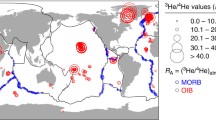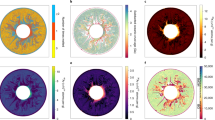Abstract
It is generally believed a variation of 3He/4He isotopic ratios in the mantle is due to only the decay of U and Th, which produces 4He as well as heat. Here we show that not only 3He/4He isotopic ratios but also helium contents can be fractionated by thermal diffusion in the lower mantle. The driving force for that fractionation is the adiabatic or convective temperature gradient, which always produces elemental and isotopic fractionation along temperature gradient by thermal diffusion with higher light/heavy isotopic ratio in the hot end. Our theoretical model and calculations indicate that the lower mantle is helium stratified, caused by thermal diffusion due to ~ 400 °C temperature contrast across the lower mantle. The highest 3He/4He isotopic ratios and lowest He contents are in the lowermost mantle, which is a consequence of thermal-diffusion fractionation rather than the lower mantle is a primordial and undegassed reservoir. Therefore, oceanic-island basalts derived from the deepest lower mantle with high 3He/4He isotopic ratios and less He contents—the long-standing helium paradox, is solved by our model. Because vigorous convection in the upper mantle had resulted in disordered or disorganized thermal-diffusion effects in He, Mid-ocean ridge basalts unaffected by mantle plume have a relatively homogenous and lower 3He/4He isotopic compositions. Our model also predicts that 3He/4He isotopic ratios in the deepest lower mantle of early Earth could be even higher than that of Jupiter, the initial He isotopic ratio in our solar system, because the temperature contrast across the lower mantle in the early Earth is the largest and less 4He had been produced by the decay of U and Th. Moreover, the early helium-stratified lower mantle owned the lowest He contents due to over-degassing caused by the largest temperature contrast. Consequently, succeeding evolution of the lower mantle is a He ingassed process due to secular cooling of the deepest mantle. This explains why significant amount of He produced by the decay of U and Th in the lower mantle were not released, another long-standing heat–helium paradox.




Similar content being viewed by others
References
Allègre CJ, Staudacher T, Sarda P, Kurz M (1983) Constraints on evolution of Earth’s mantle from rare gas systematics. Nature 303:762–766
Anderson DL (1998) The helium paradoxes. Proc Natl Acad Sci USA 95:4822–4827
Anderson DL (2007) Noble gas isotopes. In: Anderson DL (ed) New theory of the Earth, 2nd edn. Cambridge University Press, Cambridge, pp 198–210
Asaro RJ, Farkas D, Kulkarni Y (2008) The Soret effect in diffusion in crystals. Acta Mater 56:1243–1256
Brenan JM, Bennett N (2010) Soret separation of highly siderophile elements in Fe–Ni–S melts: implications for solid metal–liquid metal partitioning. Earth Planet Sci Lett 298:299–305
Butterworth NP, Talsrna AS, Mueller RD, Seton M, Bunge HP, Schuberth BSA, Shephard GE, Heine C (2014) Geological, tomographic, kinematic and geodynamic constraints on the dynamics of sinking slabs. J Geodyn 73:1–13
Chakraborty S (2010) Diffusion coefficients in olivine, wadsleyite and ringwoodite. In: Zhang YX, Cherniak DJ (eds) Diffusion in minerals and melts, Mineralogical Society of America, Chantilly, pp 603–639
Cherniak DJ, Watson EB (2012) Diffusion of helium in olivine at 1 atm and 2.7 GPa. Geochim Cosmochim Acta 84:269–279
Class C, Goldstein SL (2005) Evolution of helium isotopes in the Earth’s mantle. Nature 436:1107–1112
Demouchy S, Bolfan-Casanova N (2016) Distribution and transport of hydrogen in the lithospheric mantle: a review. Lithos 240:402–425
Dohmen R, Kasemann SA, Coogan L, Chakraborty S (2010) Diffusion of Li in olivine. Part I: experimental observations and a multi species diffusion model. Geochim Cosmochim Acta 74:274–292
Gonnermann HM, Mukhopadhyay S (2007) Non-equilibrium degassing and a primordial source for helium in ocean-island volcanism. Nature 449:1037–1040
Graham DW (2002) Noble gas isotope geochemistry of mid-ocean ridge and ocean island basalts: characterization of mantle source reservoirs. In: Porcelli D, Ballentine CJ, Wieler R (eds) Noble gases in geochemistry and cosmochemistry, Mineralogical Society of America, Chantilly, pp 247–317
Hae R, Ohtani E, Kubo T, Koyama T, Utada H (2006) Hydrogen diffusivity in wadsleyite and water distribution in the mantle transition zone. Earth Planet Sci Lett 243:141–148
Hilton DR, Porcelli D (2014) 3.7—noble gases as mantle tracers. In: Turekian KK (ed) Treatise on geochemistry, 2nd edn. Elsevier, Oxford, pp 293–325
Huang F, Chakraborty P, Lundstrom CC, Holmden C, Glessner JJG, Kieffer SW, Lesher CE (2010) Isotope fractionation in silicate melts by thermal diffusion. Nature 464:396–400
Jackson MG, Carlson RW, Kurz MD, Kempton PD, Francis D, Blusztajn J (2010) Evidence for the survival of the oldest terrestrial mantle reservoir. Nature 466:U853–U884
Jackson CRM, Parman SW, Kelley SP, Cooper RF (2013) Constraints on light noble gas partitioning at the conditions of spinel-peridotite melting. Earth Planet Sci Lett 384:178–187
Jackson MG, Konter JG, Becker TW (2017) Primordial helium entrained by the hottest mantle plumes. Nature 542:340–343
Jones TD, Davies DR, Sossi PA (2019) Tungsten isotopes in mantle plumes: heads it’s positive, tails it’s negative. Earth Planet Sci Lett 506:255–267
Kellogg LH, Turcotte DL (1987) Homogenization of the mantle by convective mixing and diffusion. Earth Planet Sci Lett 81:371–378
Kemp AIS, Hawkesworth CJ (2014) 4.11—growth and differentiation of the continental crust from isotope studies of accessory minerals A2—Holland, Heinrich D. In: Turekian KK (ed) Treatise on geochemistry, 2nd edn. Elsevier, Oxford, pp 379–421
Kleine T, Munker C, Mezger K, Palme H (2002) Rapid accretion and early core formation on asteroids and the terrestrial planets from Hf-W chronometry. Nature 418:952–955
Korte C, Janek J, Timm H (1997) Transport processes in temperature gradients—thermal diffusion and Soret effect in crystalline solids. Solid State Ion 101:465–470
Kurz MD, Jenkins WJ, Hart SR (1982) Helium isotopic systematics of oceanic islands and mantle heterogeneity. Nature 297:43–47
Lasaga AC (1998) Kinetic theory in the Earth sciences. Princeton University Press, Princeton
Li X, Liu Y (2015) A theoretical model of isotopic fractionation by thermal diffusion and its implementation on silicate melts. Geochim Cosmochim Acta 154:18–27
Mahaffy PR, Donahue TM, Atreya SK, Owen TC, Niemann HB (1998) Galileo probe measurements of D/H and He-3/He-4 in Jupiter’s atmosphere. Space Sci Rev 84:251–263
McKenzie D, Bickle MJ (1988) The volume and composition of melt generated by extension of the lithosphere. J Petrol 29:625–679
Moreira M (2013) Noble gas constraints on the origin and evolution of Earth’s volatiles. Geochem Perspect 2:229–403
Moreira M, Sarda P (2000) Noble gas constraints on degassing processes. Earth Planet Sci Lett 176:375–386
Mukhopadhyay S, Parai R (2019) Noble gases: a record of earth’s evolution and mantle dynamics. Annu Rev Earth Planet Sci 47(1):389–419
Mundl A, Touboul M, Jackson MG, Day JMD, Kurz MD, Lekic V, Helz RT, Walker RJ (2017) Tungsten-182 heterogeneity in modern ocean island basalts. Science 356:66–69
O’Neill HS, Wall VJ (1987) The Olivine—Orthopyroxene—Spinel Oxygen geobarometer, the nickel precipitation curve, and the oxygen fugacity of the Earth’s Upper Mantle. J Petrol 28:1169–1191
Onions RK, Oxburgh ER (1983) Heat and helium in the Earth. Nature 306:429–431
Oxburgh ER, Onions RK (1987) Helium loss, tectonics, and the terrestrial heat budget. Science 237:1583–1588
Parman SW, Kurz MD, Hart SR, Grove TL (2005) Helium solubility in olivine and implications for high 3He/4He in ocean island basalts. Nature 437:1140–1143
Porcelli D, Elliott T (2008) The evolution of He Isotopes in the convecting mantle and the preservation of high 3He/4He ratios. Earth Planet Sci Lett 269:175–185
Stuart FM, Lass-Evans S, Godfrey Fitton J, Ellam RM (2003) High 3He/4He ratios in picritic basalts from Baffin Island and the role of a mixed reservoir in mantle plumes. Nature 424:57–59
Sun W, Yoshino T, Sakamoto N, Yurimoto H (2015) Hydrogen self-diffusivity in single crystal ringwoodite: implications for water content and distribution in the mantle transition zone. Geophys Res Lett 42:6582–6589
Tolstikhin I, Hofmann AW (2005) Early crust on top of the Earth’s core. Phys Earth Planet Inter 148:109–130
Tucker JM, Mukhopadhyay S, Gonnermann HM (2018) Reconstructing mantle carbon and noble gas contents from degassed mid-ocean ridge basalts. Earth Planet Sci Lett 496:108–119
Van Keken PE, Ballentine CJ, Porcelli D (2001) A dynamical investigation of the heat and helium imbalance. Earth Planet Sci Lett 188:421–434
Van Keken PE, Hauri EH, Ballentine CJ (2002) Mantle mixing: the generation, preservation, and destruction of chemical heterogeneity. Annu Rev Earth Planet Sci 30:493–525
Walker D, Delong SE (1982) Soret separation of mid-ocean ridge basalt magma. Contrib Miner Petrol 79:231–240
Wang K, Brodholt J, Lu X (2015) Helium diffusion in olivine based on first principles calculations. Geochim Cosmochim Acta 156:145–153
Weismueller J, Gmeiner B, Ghelichkhan S, Huber M, John L, Wohlmuth B, Ruede U, Bunge H-P (2015) Fast asthenosphere motion in high-resolution global mantle flow models. Geophys Res Lett 42:7429–7435
White WM (2010) Oceanic island basalts and mantle plumes: the geochemical perspective. In: Jeanloz R, Freeman KH (eds) Annual review of Earth and planetary sciences, vol 38, pp 133–160
White WM (2015) Probing the Earth’s deep interior through geochemistry. Geochem Perspect 4:95–251
Wilde SA, Valley JW, Peck WH, Graham CM (2001) Evidence from detrital zircons for the existence of continental crust and oceans on the Earth 4.4 Gyr ago. Nature 409:175–178
Zhang Y (1993) A modified effective binary diffusion model. J Geophys Res Solid Earth 98:11901–11920
Zhang Y (2008) Geochemical kinetics. Princeton University Press, Princeton
Acknowledgements
We thank Dr. Huiming Bao, Yun Liu, Qingwen Zhang, Xiaobin Cao and Chunhui Li for their constructive discussions. Funding for this study comes from the Strategic Priority Research Program (B) of CAS (XDB18010100) and the Chinese NSF projects (41490635, 41530210, 41225012, 41573040).
Author information
Authors and Affiliations
Corresponding author
Electronic supplementary material
Below is the link to the electronic supplementary material.
Supplementary material 1 (AVI 8774 kb)
Supplementary material 2 (AVI 926 kb)
Rights and permissions
About this article
Cite this article
Zhu, H., Li, X. & Xu, Y. A helium stratified and ingassed lower mantle: resolving the helium paradoxes. Acta Geochim 39, 4–10 (2020). https://doi.org/10.1007/s11631-019-00378-2
Received:
Revised:
Accepted:
Published:
Issue Date:
DOI: https://doi.org/10.1007/s11631-019-00378-2




